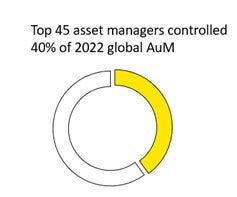EY refers to the global organization, and may refer to one or more, of the member firms of Ernst & Young Global Limited, each of which is a separate legal entity. Ernst & Young Global Limited, a UK company limited by guarantee, does not provide services to clients.

A strategic approach to transformation rooted in business' unique objectives and competencies is imperative for long-term profitable growth
In brief
- Industry Challenges: Persistent issues in asset management, like tight margins and outdated technology, were exacerbated by the volatile early 2020s, including the impact of COVID-19.
- Projected Margin Contraction: EY's model predicts a three to five percentage points reduction in aggregate operating margins by 2027, necessitating a five to seven percent cost reduction.
- Strategic Transformation: To counter challenges, asset managers must strategically realign with clients, reassess investments, embrace digitalization, target growth sectors, transform business models, and consider mergers, all guided by a top-down approach for sustainable, profitable growth.
Current industry challenges were on the horizon for some time
The first few exceptionally unstable years of the 2020s presented some of the most complex challenges for asset managers. The COVID-19 fallout, followed by soaring prices, rising interest rates, geopolitical instability, slowing economic growth, changes in client expectations and demographics profoundly altered the industry’s outlook. Subsequent uncertainty and disruption led to even more pressure on growth and profitability.
However, many of the challenges facing the industry today are far from new. They existed even before the pandemic. However, some of these challenges were eclipsed by the 2020-2021 market rally and COVID-19 stimulus bills. An indicative ~75% of the growth in assets under management (AUM) enjoyed by most asset managers in 2021 and 2022 was driven by stimulus-triggered market rallies rather than by a unique differentiation in their propositions.
Firms have long struggled with tight margins, legacy technology preventing scalability and the changing dynamics between active and passive management. These challenges, along with the macro factors, will continue to impact asset managers unless they transform their business for strategic resilience.
To contextualize the magnitude of pressure industry participants may face in the future, EY built a forward-looking model that suggests strong margin contraction between 2023 and 2027 The industry could face a reduction of three to five percentage points in aggregate operating margins in the base scenario, with four percent five-year AUM compound annual growth rate (CAGR).
To sustain margins at the 2022 level, the industry will need to trim costs by five to seven percent between 2023 and 2027 (base scenario). In the pessimistic scenario with no AUM growth, the decline in aggregate operating margins could be as steep as 13 to 15 percentage points, with costs needing to be reduced by 17% to 19% during the same period.¹

Many firms will see their profitability squeezed even more, given the ability of the largest players to capture the lion’s share of inflows and achieve economies of scale. The top 45 asset managers controlled about 40% of AUM globally, as of 2022, and 14 of these firms managed over one trillion dollars, representing 27% of the global 2022 AUM.²

In the current operating environment with increasing competition, clients are questioning the value for money, while business stakeholders present complex demands. This makes strategic transformation essential for asset managers to succeed in this decade and beyond.
Strategic transformation for profitable growth
To maintain profitability in challenging times, firms often find it easier to cut costs than to achieve top-line growth, typically resorting to tactical measures like workforce reductions, tightening expenses and minor process tweaks.
However, for long-term profitability, a more ambitious, strategic approach to costs and growth is necessary. Merely cutting costs is not enough for lasting success; strategic renewal should align with a firm’s unique objectives and strengths, avoiding generic strategies. Effective profitable growth transformation requires setting clear strategic priorities, which may include identifying quick wins for immediate benefits – but these should complement, not replace, a comprehensive strategy for change.
Firms can view strategic transformation programs through six key lenses to help improve efficiency, strengthen resilience and enable long-term profitable growth:
1. Realign around the client. Build solutions that foster outcome-driven partnerships that help clients reach their goals. Deeply understanding client’s needs and preferences is crucial for developing optimal client solutions. This approach will help asset managers differentiate by offering enhanced customer experiences and portfolio outcomes and thereby strengthening trust and loyalty.
2. Revisit investment propositions. Economic change, technology innovation and other megatrends will push asset managers to revisit the way they conduct core investment activities to stay competitive. Product and solution development need to become smarter, faster and technology-driven if firms are to implement new investment strategies at pace. Some of the key ways through which firms can enhance investment processes and product development include:
- Augment investment processes with artificial intelligence (AI) can help asset managers quickly capture sentiment on the street, perform real-time research and conduct alpha calculations. For example, a leading European asset manager uses an AI platform to forecast stock price movements. The platform analyzes vast amounts of text, including articles, call transcripts, and broker research, to detect shifts in a company’s key performance indicators and assess their impact on its stock price.³
- Consider new investment themes such as green hydrogen, quantum computing or nuclear fusion, which supports growing industries such as renewables and sustainable packaging. For example, a large European asset manager recently launched a fund that invests in Paris Agreement-aligned companies focused on five themes including AI and robotics, safety, the subscription economy, water conservation and wellness.⁴
- Explore innovations such as fractional investing, digital assets, tokenization of assets and direct indexing.
3. Accelerate digitalization and automation. These are set to revolutionize interactions among asset managers, advisors and asset owners, fostering real-time engagement and data sharing via online platforms. The integration of generative AI, human insights and customer data can further enhance transparency and personalization in digital client interactions. This technology paves the way for AI-enhanced contact centers, where bots assist staff in client interactions or handle complex enquiries. Technology enabled client service will help asset managers stand out, strengthen the brand and build enduring relationships.
4. Target growth areas. The rise of disruptive forces is creating new niches and opportunities but intensifying competition means generalized strategies are less likely to deliver outperformance. Firms can focus on high-growth sectors such as alternative investments, ESG investing and rapidly expanding markets in Asia to achieve long-term value.
5. Transform business models. This is essential for implementing growth strategies and enhancing productivity. To establish a sustainable and efficient foundation for growth, asset managers can:
- Reduce costs in absolute and relative terms
- Change fixed costs to variable costs, thereby increasing flexibility
- Make operations more scalable
- Improve cost transparency and oversight
6. Inorganic growth. Given the benefits of scale and diversification, and the ongoing fragmentation in the industry, mergers and acquisitions (M&A) will remain key for expansion. However, M&A should be strategically driven, with clear strategic goals such as acquiring specialized investment skills, entering new markets, gaining technological expertise or tapping into mature distribution networks with an established client base.
The top-down approach to profitable growth transformation
Asset managers should take a top-down approach – starting with a long-term vision, identifying capabilities and gaps, defining the target operating model, and then finally moving to solution selection and implementation. Clear strategic objectives and a focus on stakeholder value are essential for sustainable, profitable growth. Firms should also continuously monitor market trends to ensure their strategies align with their overarching goals.
At EY, we have developed a structured, comprehensive framework that adopts a progressive approach to achieve and manage profitable growth. Our top-down strategic transformation approach begin with a framework tailored to the firm’s objectives, size, business and capabilities and unique differentiators. This guides the overall transformation program - methodically adapting the current operating model towards the target of ‘profitable growth.’
What is your strategy to lead your organization through the uncertain operating environment? Talk to us to realize your transformation plans.
Get in touch
Boudewijn Chalmers Hoynck van Papendrecht
EY Netherlands Wealth & Asset Management Consulting Leader; EY Global Wealth & Asset Management Profitable Growth Solution leader.
We would like to thank the following people for their valuable contributions to this article:
- Fabrizio Colaci, Director, Wealth & Asset Management, Consulting
- Rohit Kataria, Assistant Director, Wealth and Asset Management, EY Knowledge
- Maarten Muntendam, Manager, Wealth and Asset Management, Consulting
Related articles
Are you reframing the future of asset management or is it reframing you?
AI can help unlock the transformational change that asset managers need to remain relevant in a radically different future. Learn more.
Why financial institutions should transform tax and finance functions
EY research shows banks, asset managers and insurance companies are reimagining their tax and finance functions. Read more.
Summary
The volatility of the early 2020s, exacerbated by the COVID-19 pandemic and its economic repercussions, have posed complex challenges for asset managers. While these issues have intensified, they existed before the pandemic—masked somewhat by the market rally and stimulus bills of 2020-2021. Asset managers continue to grapple with declining margins, legacy technology and changing dynamics of active and passive management. EY's model predicts a significant contraction in aggregate operating margins between 2023 and 2027, necessitating cost reductions. To navigate this, asset managers must embrace a strategic approach, focusing not just on cost-cutting but a comprehensive strategy for transformation. Key lenses through which firms can view transformation programs include client realignment, revisiting investment propositions, acceleration of digitalization and automation, targeting growth areas, transforming business models, and inorganic growth. EY's progressive approach to strategic transformation guides this process towards achieving and sustaining profitable growth.


